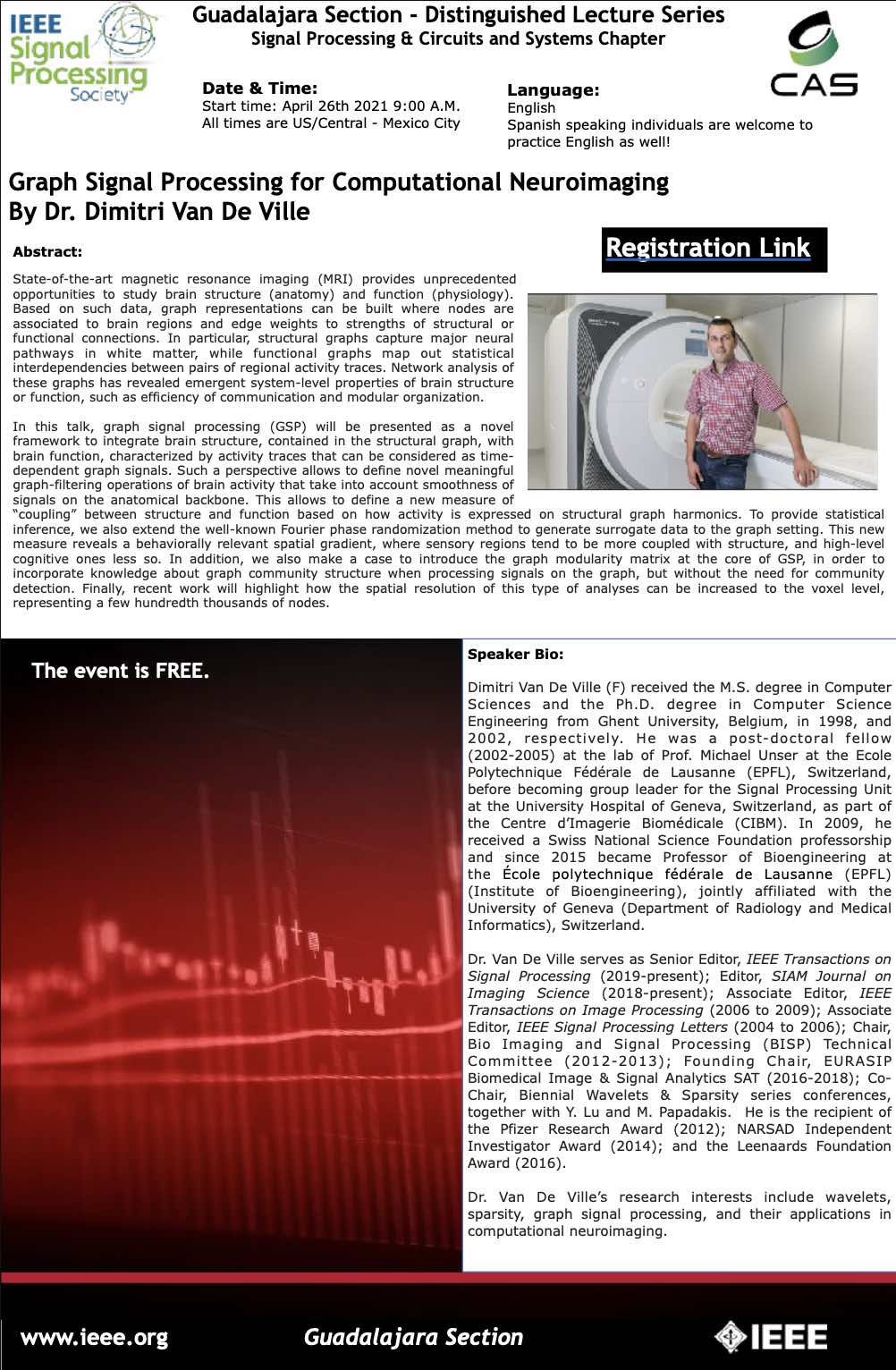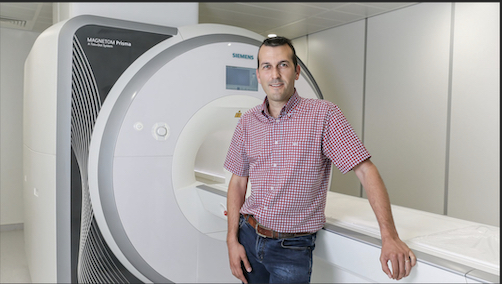Graph Signal Processing for Computational Neuroimaging, by Dr. Dimitri Van De Ville
Graph Signal Processing for Computational Neuroimaging, by Dr. Dimitri Van De Ville

Abstract:
State-of-the-art magnetic resonance imaging (MRI) provides unprecedented opportunities to study brain structure (anatomy) and function (physiology). Based on such data, graph representations can be built where nodes are associated to brain regions and edge weights to strengths of structural or functional connections. In particular, structural graphs capture major neural pathways in white matter, while functional graphs map out statistical interdependencies between pairs of regional activity traces. Network analysis of these graphs has revealed emergent system-level properties of brain structure or function, such as efficiency of communication and modular organization.
In this talk, graph signal processing (GSP) will be presented as a novel framework to integrate brain structure, contained in the structural graph, with brain function, characterized by activity traces that can be considered as time-dependent graph signals. Such a perspective allows to define novel meaningful graph-filtering operations of brain activity that take into account smoothness of signals on the anatomical backbone. This allows to define a new measure of “coupling” between structure and function based on how activity is expressed on structural graph harmonics. To provide statistical inference, we also extend the well-known Fourier phase randomization method to generate surrogate data to the graph setting. This new measure reveals a behaviorally relevant spatial gradient, where sensory regions tend to be more coupled with structure, and high-level cognitive ones less so. In addition, we also make a case to introduce the graph modularity matrix at the core of GSP, in order to incorporate knowledge about graph community structure when processing signals on the graph, but without the need for community detection. Finally, recent work will highlight how the spatial resolution of this type of analyses can be increased to the voxel level, representing a few hundredth thousands of nodes.
Date and Time
Location
Hosts
Registration
-
 Add Event to Calendar
Add Event to Calendar
Speakers
 Ph.D. Dimitri Van De Ville of EPFL
Ph.D. Dimitri Van De Ville of EPFL
Graph Signal Processing for Computational Neuroimaging, by Dr. Dimitri Van De Ville
Abstract:
State-of-the-art magnetic resonance imaging (MRI) provides unprecedented opportunities to study brain structure (anatomy) and function (physiology). Based on such data, graph representations can be built where nodes are associated to brain regions and edge weights to strengths of structural or functional connections. In particular, structural graphs capture major neural pathways in white matter, while functional graphs map out statistical interdependencies between pairs of regional activity traces. Network analysis of these graphs has revealed emergent system-level properties of brain structure or function, such as efficiency of communication and modular organization.
In this talk, graph signal processing (GSP) will be presented as a novel framework to integrate brain structure, contained in the structural graph, with brain function, characterized by activity traces that can be considered as time-dependent graph signals. Such a perspective allows to define novel meaningful graph-filtering operations of brain activity that take into account smoothness of signals on the anatomical backbone. This allows to define a new measure of “coupling” between structure and function based on how activity is expressed on structural graph harmonics. To provide statistical inference, we also extend the well-known Fourier phase randomization method to generate surrogate data to the graph setting. This new measure reveals a behaviorally relevant spatial gradient, where sensory regions tend to be more coupled with structure, and high-level cognitive ones less so. In addition, we also make a case to introduce the graph modularity matrix at the core of GSP, in order to incorporate knowledge about graph community structure when processing signals on the graph, but without the need for community detection. Finally, recent work will highlight how the spatial resolution of this type of analyses can be increased to the voxel level, representing a few hundredth thousands of nodes.
Biography:
Dimitri Van De Ville (F) received the M.S. degree in Computer Sciences and the Ph.D. degree in Computer Science Engineering from Ghent University, Belgium, in 1998, and 2002, respectively. He was a post-doctoral fellow (2002-2005) at the lab of Prof. Michael Unser at the Ecole Polytechnique Fédérale de Lausanne (EPFL), Switzerland, before becoming group leader for the Signal Processing Unit at the University Hospital of Geneva, Switzerland, as part of the Centre d’Imagerie Biomédicale (CIBM). In 2009, he received a Swiss National Science Foundation professorship and since 2015 became Professor of Bioengineering at the École polytechnique fédérale de Lausanne (EPFL) (Institute of Bioengineering), jointly affiliated with the University of Geneva (Department of Radiology and Medical Informatics), Switzerland.
Dr. Van De Ville serves as Senior Editor, IEEE Transactions on Signal Processing (2019-present); Editor, SIAM Journal on Imaging Science (2018-present); Associate Editor, IEEE Transactions on Image Processing (2006 to 2009); Associate Editor, IEEE Signal Processing Letters (2004 to 2006); Chair, Bio Imaging and Signal Processing (BISP) Technical Committee (2012-2013); Founding Chair, EURASIP Biomedical Image & Signal Analytics SAT (2016-2018); Co-Chair, Biennial Wavelets & Sparsity series conferences, together with Y. Lu and M. Papadakis. He is the recipient of the Pfizer Research Award (2012); NARSAD Independent Investigator Award (2014); and the Leenaards Foundation Award (2016).
Dr. Van De Ville’s research interests include wavelets, sparsity, graph signal processing, and their applications in computational neuroimaging.
Address:Switzerland, Switzerland

